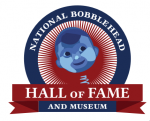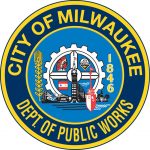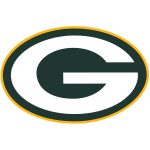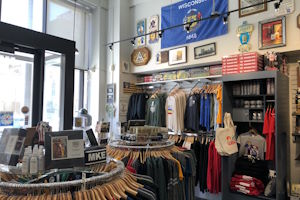Milwaukee Founders and Beer Barons Bobblehead Series Unveiled to Celebrate 414 Day
MILWAUKEE – This morning, to celebrate Milwaukee’s 414 Day, the National Bobblehead Hall of Fame and Museum unveiled the first Milwaukee Founders and Beer Barons Bobblehead Series. The bobbleheads include Milwaukee founders Solomon Juneau, Byron Kilbourn, and George H. Walker, and Milwaukee beer barons Valentin Blatz, Frederick Miller, Frederick Pabst, and Joseph Schlitz. The bobbleheads are being released in conjunction with Milwaukee Day (aka 414 Day) which is celebrated annually on April 14th. The special edition bobbleheads are being produced by the National Bobblehead Hall of Fame and Museum.
Solomon Juneau, born in Repentigny, Quebec, worked as a clerk in the fur trade before becoming an agent for the American Fur Company in Milwaukee. Juneau had been summoned to the Milwaukee area by Jacques Vieau, a French-Canadian fur trader and the first permanent white settler in Milwaukee. In 1818, Vieau hired Juneau, based on the accounting prowess Juneau had become known for, and Juneau’s reputation for being able to deal well with local Native Americans. Juneau went on to found what was to become the City of Milwaukee. He was the first mayor of Milwaukee from 1846 until 1847 and was appointed its first Postmaster.
Byron Kilbourn, born in Granby, Connecticut, first visited Wisconsin in 1834 and worked as a government surveyor in the Green Bay area. He later deemed the area near the Milwaukee River to be a promising location for commerce, and he purchased land there. In 1837, Kilbourn founded Kilbourntown (present-day Westown) and was a key figure in the Milwaukee Bridge War in 1845. Along with Solomon Juneau and George H. Walker, Kilbourn went on to form the City of Milwaukee. Kilbourn was elected Milwaukee’s third and eighth mayor, serving two non-consecutive terms in 1848 and 1854.
Valentin Blatz, born in Mittenberg, Bavaria, immigrated to America in August 1848 and moved to Milwaukee in 1849. Blatz, who worked at his father’s brewery in his youth, established a brewery next to Johann Braun’s City Brewery in 1850 and merged both breweries upon Braun’s death in 1852. The Blatz Brewing Company became one of Milwaukee’s industrial brewing giants. The brewery produced Milwaukee’s first individually bottled beer in 1874. In 1875, Blatz was the first Milwaukee brewery to have a bottling department to package beer and ship nationally. The company operated from 1851 to 1959, when it was purchased by Pabst Brewing Company.
Frederick Miller, born in Riedlingen, Wurttemberg, emigrated with his young family to the United States in 1854. After spending the first year in New York, the Millers moved to Wisconsin in 1855. Miller, who learned the brewing business in Germany, founded the Miller Brewing Company at the Plank Road Brewery in 1855. The brewery’s location in what is now the Miller Valley provided easy access to raw materials produced on nearby farms. Following Miller’s death at age 63 in 1888, the company was run by his three surviving sons and son-in-law Carl. Molson Coors acquired the full global brand portfolio of Miller Brewing Company in 2016 and operates the Miller Brewery at the site of the original complex.
Frederick Pabst, born in the Kingdom of Prussia, emigrated with his parents to the United States in 1848. Settling first in Milwaukee, and then Chicago, Pabst later became a cabin boy on a Lake Michigan steamer. By the time he was 21, Pabst had earned his pilot’s license, and was captain of one of these vessels. In this capacity, he met Phillip Best, the owner of a small but prosperous brewery founded by his father, Jacob Best. Pabst married Best’s daughter, Maria, on March 25th, 1862. For the next year and a half, Pabst continued to navigate the waters of Lake Michigan as a ship’s captain, until an accident in December 1863 led to a change in career when he purchased half of Best’s brewing company. Before long, Pabst raised the output of the Best brewery to 100,000 barrels a year. He became president of the corporation in 1873. In 1882, Pabst added blue ribbons around the necks of “Best Select” beer bottles. In 1889, the brewing company’s name was changed to the Pabst Brewing Company. The brewing company’s renowned “Blue Ribbon” label was introduced in the 1890s. In 1899, the company sold 100 million barrels and officially changed the brand name to Pabst Blue Ribbon.
“We’re excited to unveil the Milwaukee Founders and Beer Barons Bobblehead Series on 414 Day,” National Bobblehead Hall of Fame and Museum co-founder and CEO Phil Sklar said. “These seven men are notable figures in the history of Milwaukee and instrumental in the city’s growth. These bobbleheads are sure to be popular among history buffs and beer lovers!”
About the National Bobblehead Hall of Fame and Museum:
The National Bobblehead Hall of Fame and Museum, which is located at 170 S. 1st St. in Milwaukee, Wisconsin, opened to the public on February 1st, 2019. The HOF and Museum also produces high quality, customized bobbleheads for retail sale as well as organizations, individuals, and teams across the country. Visit us online and on Facebook, Twitter and Instagram.
NOTE: This press release was submitted to Urban Milwaukee and was not written by an Urban Milwaukee writer. While it is believed to be reliable, Urban Milwaukee does not guarantee its accuracy or completeness.
























